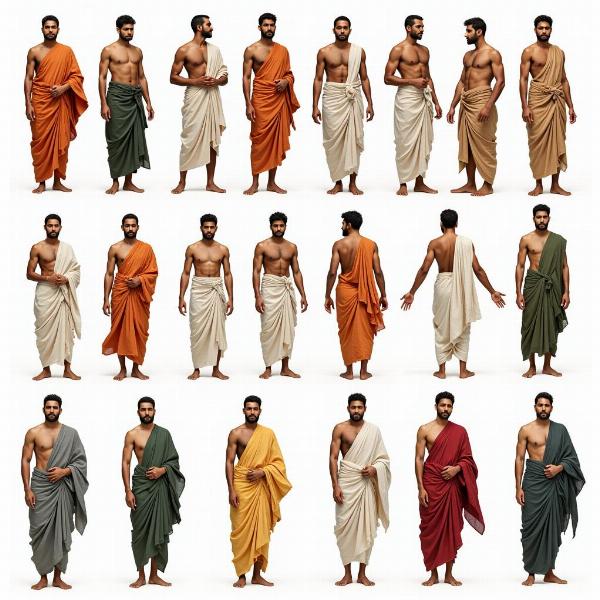Mundu meaning in Hindi is essentially a lower garment, often translated as “dhoti” or “lungi”. However, the word “mundu” carries specific cultural connotations, particularly within South Indian communities like Kerala and parts of Karnataka and Tamil Nadu. Understanding the mundu’s cultural nuances goes beyond a simple translation, reflecting traditions, social status, and even regional variations. This article delves deeper into the mundu meaning in Hindi, exploring its origins, types, and its enduring presence in modern India.
The Mundu: More Than Just Clothing
The mundu meaning in Hindi, while encompassing the basic concept of a wrapped garment, doesn’t fully capture its rich history. Unlike the more commonly known dhoti, often associated with North India, the mundu holds a distinct place in South Indian culture, representing a tradition passed down through generations. Its simplicity belies its significance, serving as everyday wear, formal attire, and even a symbol of regional identity.
Regional Variations and the Mundu’s Many Forms
The mundu, while sharing a basic structure, exhibits regional variations in color, fabric, and draping style. In Kerala, the traditional mundu is often a simple, pristine white, sometimes adorned with a colored border called a “kara.” Formal occasions might see the mundu paired with a decorative “melmundu,” a cloth draped over the shoulder. Other regions might favor different colors or patterns, reflecting local customs and preferences. Understanding these nuances enriches the understanding of the mundu meaning in Hindi, showcasing its diverse expressions.
The Mundu in Modern India
Despite the influx of Western clothing, the mundu maintains a strong presence in modern India, particularly in the southern states. Its comfort and practicality make it a popular choice for everyday wear, while its cultural significance ensures its place in ceremonies and festivals. The continued use of the mundu speaks volumes about its enduring appeal and its connection to cultural identity.
From Everyday Wear to Ceremonial Attire: The Mundu’s Versatility
The mundu’s versatility is a key aspect of its cultural significance. From casual daily wear to formal occasions like weddings and religious ceremonies, the mundu adapts to the context. This adaptability contributes to its continued relevance in contemporary society, bridging tradition and modernity.
Mundu Meaning in Hindi: A Cultural Lens
The true mundu meaning in Hindi goes beyond a literal translation, encompassing a tapestry of cultural traditions and social values. It represents a connection to regional heritage, a symbol of respect, and a practical garment suited to the Indian climate. By understanding its various forms and the customs surrounding its use, we gain a deeper appreciation for the mundu’s place in Indian society.
 Different Mundu Draping Styles
Different Mundu Draping Styles
Conclusion: Embracing the Mundu’s Cultural Legacy
The mundu, a simple yet profound garment, carries with it a rich cultural legacy. From its regional variations to its enduring presence in modern India, the mundu meaning in Hindi extends far beyond a basic definition. By understanding its significance, we gain a deeper appreciation for the cultural tapestry of India.
FAQ
-
What is the difference between a mundu and a dhoti? While both are lower garments, the mundu is typically associated with South India and features a single piece of cloth, whereas the dhoti, more common in North India, often involves tucking and draping multiple folds.
-
What fabric is a mundu usually made of? Mundus are traditionally made of cotton, although silk and other fabrics are also used for special occasions.
-
Is the mundu only worn by men? While predominantly worn by men, women also wear mundu-like garments, particularly in some communities and during certain cultural events.
-
Are there specific customs associated with wearing a mundu? Yes, different regions and communities have specific customs regarding the draping style, color, and occasions for wearing a mundu.
-
Where can I buy a traditional mundu? Traditional mundus can be purchased in local markets and textile shops, especially in South India. Online retailers also offer a variety of options.
Connect with Meaning-Hindi.in for Your Translation Needs
Meaning-Hindi.in is your premier destination for professional Hindi translation services, catering to diverse needs from business documents to legal texts, technical manuals, website localization, educational materials, and more. We provide accurate, culturally sensitive translations that bridge language barriers and facilitate effective communication. Whether you need quick turnaround times or specialized expertise, our team of experienced translators is here to assist you. Contact us today to discuss your project and experience the Meaning-Hindi.in difference. Email: [email protected], Phone: +91 11-4502-7584. Connect with Meaning-Hindi.in for seamless and professional translation services.